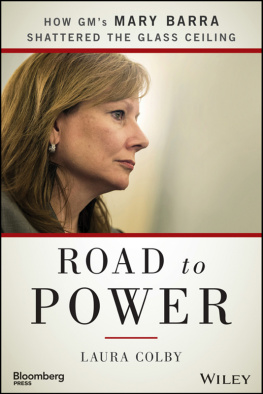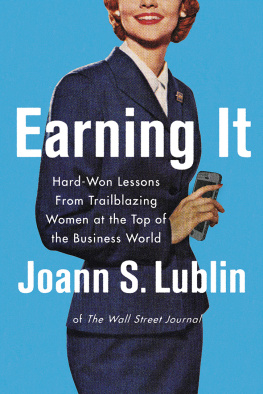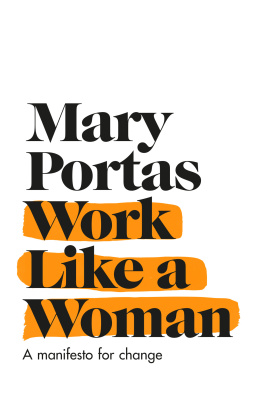
Since 1996, Bloomberg Press has published books for financial professionals, as well as books of general interest in investing, economics, current affairs, and policy affecting investors and business people. Titles are written by well-known practitioners, BLOOMBERG NEWS reporters and columnists, and other leading authorities and journalists. Bloomberg Press books have been translated into more than 20 languages.
For a list of available titles, please visit our Web site at www.wiley.com/go/bloombergpress.
Cover image: Brendan Smialowski/Getty Images
Cover design: Michael J. Freeland
Copyright 2015 by Laura Colby. All rights reserved.
Published by John Wiley & Sons, Inc., Hoboken, New Jersey.
Published simultaneously in Canada.
No part of this publication may be reproduced, stored in a retrieval system, or transmitted in any form or by any means, electronic, mechanical, photocopying, recording, scanning, or otherwise, except as permitted under Section 107 or 108 of the 1976 United States Copyright Act, without either the prior written permission of the Publisher, or authorization through payment of the appropriate per-copy fee to the Copyright Clearance Center, Inc., 222 Rosewood Drive, Danvers, MA 01923, (978) 750-8400, fax (978) 646-8600, or on the Web at www.copyright.com. Requests to the Publisher for permission should be addressed to the Permissions Department, John Wiley & Sons, Inc., 111 River Street, Hoboken, NJ 07030, (201) 748-6011, fax (201) 748-6008, or online at www.wiley.com/go/permissions.
Limit of Liability/Disclaimer of Warranty: While the publisher and author have used their best efforts in preparing this book, they make no representations or warranties with respect to the accuracy or completeness of the contents of this book and specifically disclaim any implied warranties of merchantability or fitness for a particular purpose. No warranty may be created or extended by sales representatives or written sales materials. The advice and strategies contained herein may not be suitable for your situation. You should consult with a professional where appropriate. Neither the publisher nor author shall be liable for any loss of profit or any other commercial damages, including but not limited to special, incidental, consequential, or other damages.
For general information on our other products and services or for technical support, please contact our Customer Care Department within the United States at (800) 762-2974, outside the United States at (317) 572-3993 or fax (317) 572-4002.
Wiley publishes in a variety of print and electronic formats and by print-on-demand. Some material included with standard print versions of this book may not be included in e-books or in print-on-demand. If this book refers to media such as a CD or DVD that is not included in the version you purchased, you may download this material at http://booksupport.wiley.com. For more information about Wiley products, visit www.wiley.com.
Library of Congress Cataloging-in-Publication Data:
Colby, Laura.
Road to power : how GM's Mary Barra shattered the glass ceiling / Laura Colby.
pages cm
Includes bibliographical references and index.
ISBN 978-1-118-97263-2 (cloth); ISBN 978-1-118-97266-3 (ebk); ISBN 978-1-118-97265-6 (ebk) 1. Barra, Mary. 2. General Motors Corporation. 3. Automobile industry and trade--United States--Biography. 4. Women executives--Biography. 5. Businesswomen--Biography. I. Title.
HD9710.U52B333 2015
338.7'629222092--dc23
[B]
2014047584

For Allegra, and all the other members of the next generation
Preface
Just don't go there.
That was Mary Barra's advice when, in March 2012, she was asked at a meeting of Michigan's women in business organization, Inforum, about whether she had experienced discrimination as a female manager during her career. Hard as that is to believecoming from a rare woman engineer, who started on a factory floor at the age of 18 back in the early 1980sBarra denied ever being held back by being female. I never said, that happened to me because Im a woman.'
Like many women of her generation, Barra played down gender as her career advanced. And she rose through the ranks of General Motors, a company that caught on early to the idea that women make up not only a large portion of the potential workforce, but also a huge share of potential customers. Encouraging women to become leaders made business sense, executives told me over and over again, because women represent a large proportion of car buyers. GM's moves to include women didn't come in a vacuum, though: They followed a string of U.S. government actions that made the company take noticeincluding a discrimination lawsuit.
Pushed or not, GM has been more successful than most large companies at cultivating high-ranking women, especially starting with Barra's generation. Though the numbers of women on the board and in management still lag behind men, they are at least twice the average of other large publicly traded companies that make up the Standard & Poor's 500 index. Some 26 percent, or six of the 23 top corporate officers are women, and there's a cadre of female vice presidents behind them. That compares with 8 percent for the S&P 500 index companies. There are four women on the company's 12-member board of directors, or 33 percent, versus an average of 18 percent for other S&P 500 companies.
GM, especially in 2014 after it was disclosed to have failed to recall millions of cars that had a potentially deadly defect for more than a decade, has been criticized time and again for its bureaucratic culture, where a focus on process can supersede common sense. Yet in reporting this book, one thing that has struck me is that the same obsession with systems and processes has had a big role in creating a cadre of women, including Barra, who are just now getting to the top.
GM executives began reaching out to women as early as the 1970s, as the women's liberation movement was changing the way workforces operated. The steps accelerated and became more concrete following the company's 1983 settlement of a decade-old employment discrimination complaint with the Equal Employment Opportunity Commission (EEOC). Under the landmark deal, reached while Mary Barra was a college student at what was then the General Motors Institute, GM agreed to set goals for the promotion of women and minorities and to report back to the EEOC on its progress. Managers were asked regularly where the women in their areas were, and were encouraged to seek out female talent.
Throughout her career, Barra had mentors both male and female who tried to make sure she got opportunities to grow and advance. Once she was designated a high-potential employee, she was rotated through different positions in the company, at times well beyond her comfort and skill level. By embracing those new challenges, Barra deepened her knowledge and skills and was able to become a better manager. She in turn helped other women, both informally and formally, including setting up an internal networking group for women at the company in the 1990s.
Barra went through a decades-long grooming process before ascending to the top. One of the most striking things about her career is how close she was to some of the most important inflection points in the company's history. Like an automotive Forrest Gumpbut smartershe was often just below the radar, not yet powerful enough to get noticed by outsiders. Still, she was there, soaking up knowledge, learning lessons from the company's successes and failures, and building a network of mentors and supporters.
Next page












